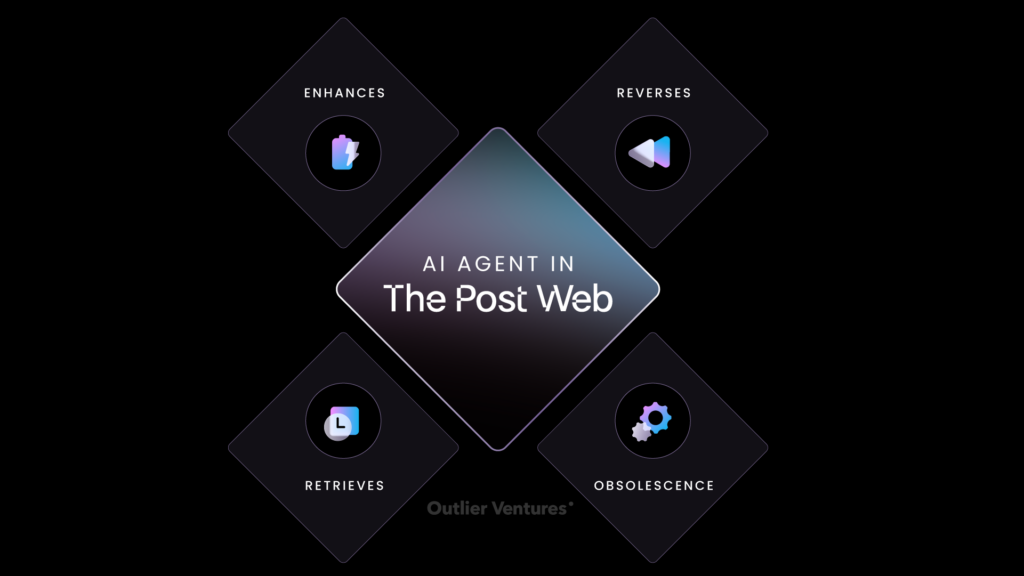A Deep Dive into AI Agents: What’s Next After the Hype?
By Outlier Ventures
Compiled by: Felix, PANews
The accelerated integration of AI and decentralized technology infrastructure is fundamentally changing the entire Internet landscape.
This powerful synergy is giving rise to a new era in which autonomous AI agents are no longer just a futuristic concept, but are becoming a reality that will redefine how we interact with the Internet and conduct economic activities.
But with all the hype surrounding proxies these days, the real question is: what does the future hold?
Agent is a brand new interface designed specifically for delegation
These intelligent systems, capable of interpreting user intent and performing complex tasks with minimal human intervention, represent a significant shift that will unlock endless possibilities for innovation across industries. The Post Web paper’s framework and expectations for the evolution of current web paradigms provide critical context for understanding and leveraging the evolving field of AI agents.
The paper argues that the core concept of agency is delegation. Instead of manually clicking and browsing the Internet, users delegate their intentions to AI agents, which then operate on their behalf in services, infrastructure, and markets.

This shift opens up huge opportunities, starting with the tools and infrastructure needed to power proxy systems. We expect there will be huge demand for:
-
Agent SDK and training framework
-
Orchestration layer for multi-agent coordination
-
Secure deployment environment
-
Tools for defining, validating, and monitoring agent behavior
-
As the number and variety of agents proliferates, so too does the need for systems that can manage complexity and ensure trust.
Building Trust in Autonomous Agents
The key to the successful adoption of autonomous agents is to establish unwavering trust. This requires the development of strong security protocols and transparent verification mechanisms, potentially leveraging the immutable nature of distributed ledger technology (DLT), to ensure that agents act in accordance with user intent and effectively reduce the risk of malicious behavior. On-chain verification of agent behavior will enable:
-
Transparent audit trail
-
Encryption ensures compliance
-
Mitigating malicious behavior
-
Agent Reputation and Accountability
The Intention Economy relies on these mechanisms because trust is key to achieving scale.
The rise of professional AI agents
In the envisioned Intention Economy, the Internet will be optimally organized around solving user intent, which will greatly drive the demand for specialized AI agents for specific needs and uses.
-
Personal proxy: handles everything from scheduling to finances
-
Financial Agent: Execute decentralized financial transactions and manage digital assets
-
Data and research agency: collect and organize high-quality data
-
DAO Governance Proxy: Participate in Voting and Decentralized Governance
Each area of expertise creates new opportunities for entrepreneurs.
Proxy stack
Affiliates don’t appear in a vacuum. They require an entire ecosystem to operate, grow, and unlock real economic value. This is the real frontier for entrepreneurs: building tools and devices for the agency economy. Here are some of the biggest opportunities:
Proxy Market and Reputation System
The rise of AI agents will give rise to a Wild West of online services where not every agent can be trusted.
Founders who can build marketplaces where users can find, verify, and deploy reliable agents will have a huge first-mover advantage. Imagine an “app store” built specifically for autonomous agents:
-
Compare the actual performance of the agents (speed, success rate, security), not just what they claim
-
On-chain reputation can prove the long-term performance of agents, making it easy to identify reliable and high-risk services
-
Intelligent matching engine connects users with the right agent for their job in real time
Trust is critical, and those marketplaces that can verify trust will win.
Personalized interface and the role of " Thin Web "
Even in an agent-driven world, humans still crave interaction, creating a huge demand for dynamic, personalized interfaces that adapt in real time to the user’s intent, preferences, and needs.
Enter the “ Thin Web ”: a unique interface generated on the fly by AI agents, tailored to the user.
Imagine shopping experiences that feel like private consultations, games that adjust in real time based on a player’s play style, and social apps that surface connections or communities based on deeper signals of intent.
Entrepreneurs who build these human-centric layers on top of agentic infrastructure will shape the emotional and social fabric of the new era.
The infrastructure behind the proxy
Proxies require resources to run: computing, storage, bandwidth, and identity. The bottleneck of centralization is that it cannot be scaled and cannot be trusted. This is where DePIN comes into play:
-
Distributed computing for agent training and inference.
-
Decentralized storage for proxy memory and data persistence.
-
Ubiquitous and resilient connectivity layer for coordination between agents.
Building APIs, smart contracts, and dApps that enable agents to autonomously and securely access decentralized infrastructure is a huge open design space, and smart entrepreneurs are already starting to build it.
Together, these layers form the new digital backbone, the invisible engine room of the agency economy. Building for this stack is not only a technical challenge, but a once-in-a-decade opportunity to lay the foundation for the future web and define a new era of life.
What’s next for agency innovation?
Realizing the full potential of AI agents depends on the continued improvement of their core capabilities.
This evolution will be driven by advances in learning paradigms such as reinforcement learning (RL) and retrieval-augmented generation (RAG), which can improve decision-making, situational awareness, and reasoning. As agents begin to collaborate to solve complex problems, secure and efficient inter-agent communication and coordination protocols will also be required, driving the rise of complex multi-agent systems.
But innovation cannot happen in isolation. Solving foundational challenges will open up new opportunities across the board.
First, digital identity and reputation systems for agents must be built from the ground up to ensure accountability and build trust. As agents become integrated into everything from personal finance to corporate operations, clear governance frameworks are critical to preventing abuse and protecting users.
At the same time, breakthroughs in privacy-enhancing techniques (PETs) and secure communication protocols are crucial to enable the delegation of sensitive tasks without leaking user data.
The future of agent innovation requires not only intelligence, but also a great deal of infrastructure and trust. Those who build the tools, systems, and standards for this emerging layer will shape not only the future of AI, but all aspects of future life.
Related reading: Taking stock of AI Agent’s recent product optimization and technological innovation, can the six popular projects break out after their market value fell below 90%?
You May Also Like

Delabs Games' Ragnarok Libre officially launched and launched the first season of airdrop activities

Chainlink Made a Historic Partnership with Mastercard to Let 3B+ Cardholders Buy Crypto On-chain
